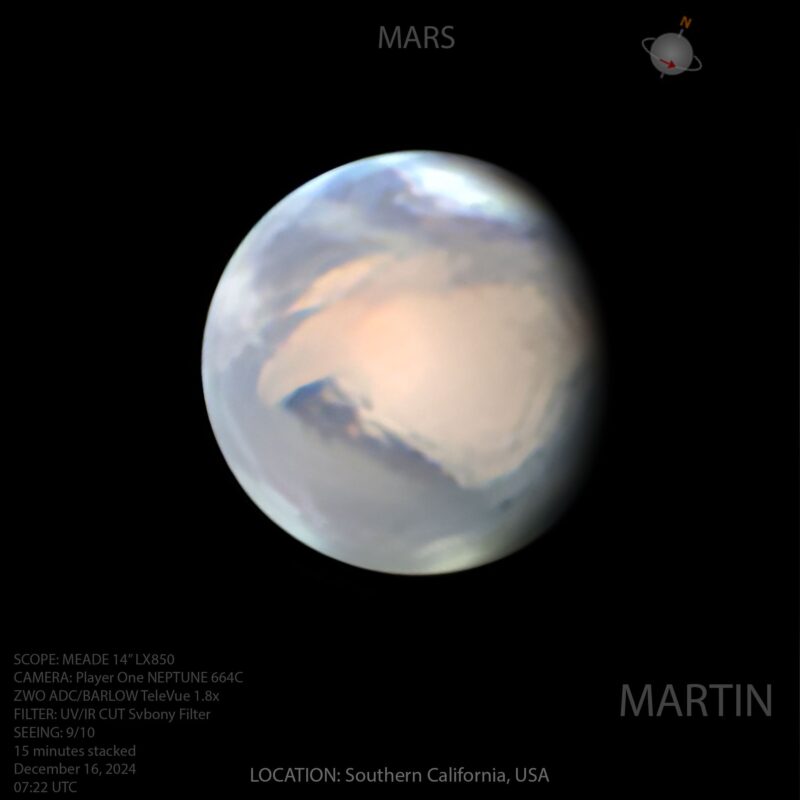The 2025 EarthSky lunar calendar makes a great gift. Get yours today!
New Year’s Star Sirius and 2 planets to ring in 2025
Want to entertain your friends on New Year’s Eve? Show them the New Year’s Star, Sirius, the brightest star in Earth’s night sky. This star always reaches its highest point in the sky around the stroke of midnight on New Year’s Eve. And, in 2025, Sirius will have company. It’ll be joined by two extra-bright planets, Jupiter and Mars, both now nearly at their closest to Earth for this year. Wow, what an eye-catching sight!
Sirius also has the nickname the Dog Star, because it’s part of the constellation Canis Major the Greater Dog. It’s a noticeable sight in our sky every evening during Northern Hemisphere winter (Southern Hemisphere summer). But its midnight culmination – its highest point in the sky at midnight – always comes around New Year’s Eve.
And this year Jupiter, Mars and Sirius will provide a triple whammy in brightness! You can look for this trio any time now. Keep reading, to learn more about how to identify them.
Sirius, Mars and Jupiter are all bright
So how can you find these objects? There are a lot of bright stars in the evening sky now. But – just remember – Sirius is the brightest star in Earth’s night sky. In fact, the name Sirius means sparkling or scorching in both Latin and Greek.
And the planets are as bright as – or brighter than – glittering Sirius! As 2024 ends and 2025 begins, Earth just passed between Jupiter and the sun (on December 7), bringing that planet closest to us for this year. Jupiter is always bright, but it’s especially bright right now. Jupiter shines more brightly than Sirius.
Meanwhile, Earth will pass between Mars and the sun on January 15-16. So Mars is bright now, too, and very red in color. Bright red planet Mars is roughly the same brightness as Sirius.
The three objects near each other in the sky will surely catch your eye.
Also, remember, our solar system is a flat plane. So, the planets follow more or less the path of the sun across our sky. No matter where you are on Earth, look along the sun’s path, or ecliptic, for Jupiter and Mars. Sirius will be nearby.
Locating Sirius
Need more help to identify Sirius? Here’s a sure-fire way to know. Look for three prominent stars in a row. They have the same size and brightness. These stars form the Belt of the constellation Orion the Hunter. Orion’s Belt always points to Sirius.


Sirius is always up late for the party
In late 2024 and early 2025, there are several bright planets (Jupiter, Mars, plus Venus in the west just after sunset) in the night sky now. The planets are “wanderers.” They don’t stay fixed with respect to the star background. Meanwhile, bright Sirius is highest in the sky at midnight during every turn of the year.
To clarify, by midnight, we mean the middle of the night, that is, midway between sunset and sunrise. Like the sun, the stars rise in the east and travel westward across the sky. When the sun or any star is in the eastern half of the sky, it’s climbing upward or ascending. When the sun or any star is in the western sky, it’s descending downward. Therefore, midway between rising and setting, the sun or any star reaches its highest point in the sky.
Because the stars rise and set two hours earlier with each passing month, Sirius will be highest up for the night around 10 p.m. local time on February 1. By then, Earth will have passed both Jupiter and Mars in orbit around the sun. We’ll be fleeing ahead of both worlds. But they’ll still be near Sirius in the sky … and all three will still be bright!
Mars and Jupiter from our Community Photos


Bottom line: Look for bright giant Jupiter, the brightest star in the sky, Sirius, and red Mars, midway between sunset and sunrise, on New Year’s Eve.
Read our previous article: Parker Solar Probe to touch the sun on December 24
